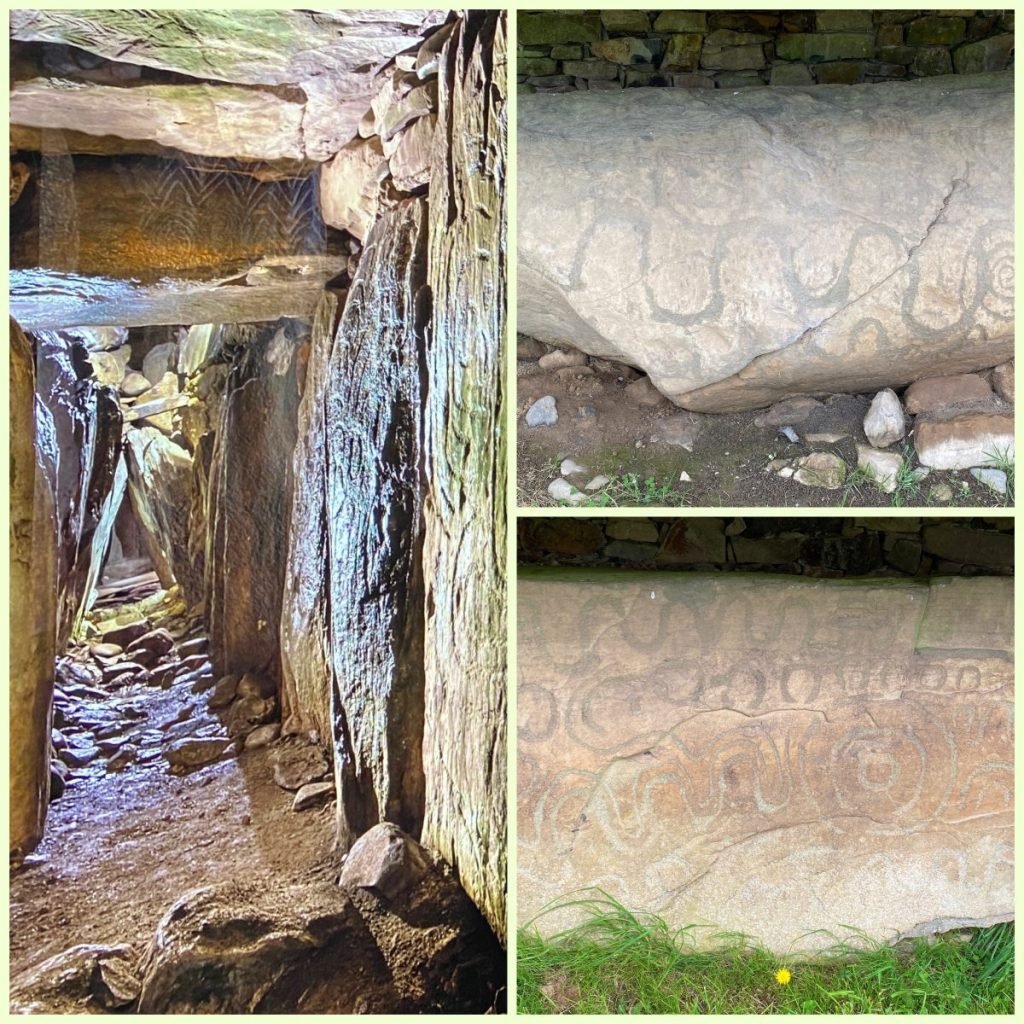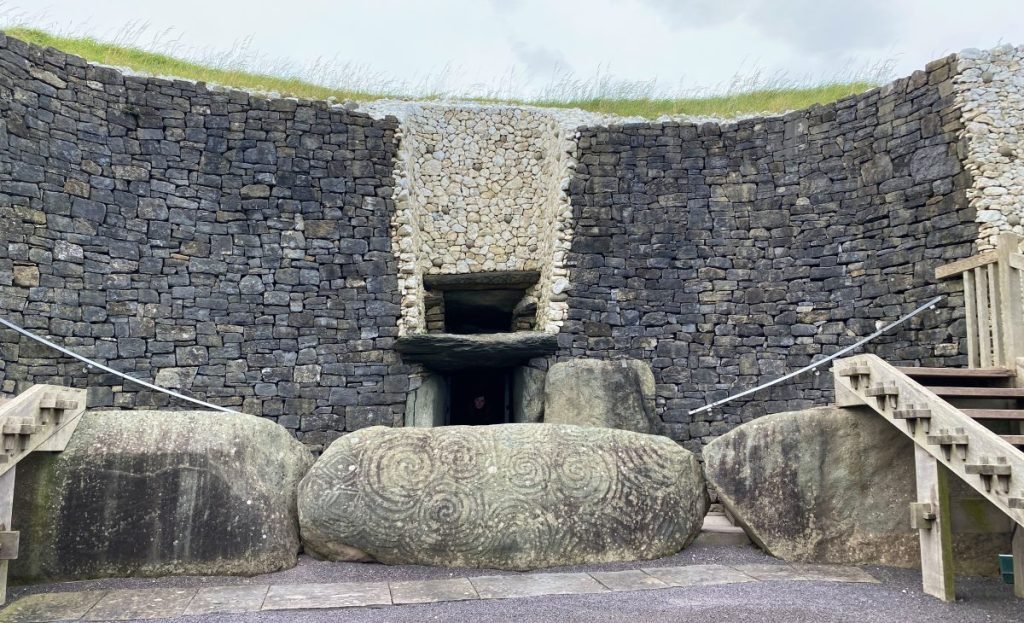Three massive stones create the entrance into the Newgrange Passage tomb, an ancient megalithic structure older than the Pyramids in Egypt. One huge slab on each side supports a single stone resting across the top. We ducked slightly to enter. The cool air embraced us as soon as we crossed the threshold inviting us to explore further. We were entering a corridor built 5,000 years ago. We felt like children on an adventure as we crept toward the inner chamber wondering what we would find there.

Brú na Bóinne Valley, Ireland
The Brú na Bóinne Valley is home to three major prehistoric World Heritage sites. It is just under one hour drive north of Dublin.
Newgrange (Sí an Bhrú)

The passage tomb at the Newgrange site in the Brú na Bóinne Valley is estimated to have been built in 3,200 BC. These estimates make it older than the Pyramids in Egypt and Stonehenge in England.
The exterior of the mound was largely overgrown when it was rediscovered in the 1800s. Archaeologists have reconstructed the exterior with white quartz cobblestones that were found on site. The interpretation for reconstruction is disputed but no one knows what the original looked like nor why it was constructed. Our guides encouraged us to use our imaginations.

The Inner Chamber at Newgrange
The inner passage and chambers penetrate a third of the way into the mound and is 60 feet (19 meters) long. It has withstood the test of five millenniums.
We ducked and squeezed our way down the narrow passage and were rewarded when we reached the inner chamber with space to comfortably move around. The stone cap of the inner chamber was 15 feet above our heads. Protected from outside elements, the bones of our ancestors were discovered here. Sounds from the outside world were deadened by the 200,000 tons of rocks and earth enveloping us.
Two from our group never made it to this inner chamber, they turned around due to claustrophobia near the entrance. The remaining five of us stood listening to our guide tell us what little was known of the megalithic art surrounding us.
Then came the moment I love. As if we were in a deep cave or mine, the guide flipped a hidden switch and we were plunged into total darkness. Our eyes were no longer able to detect even the slightest strand, and then our other senses took over.
Utter darkness
Total darkness on a cloud-covered night in the wide open vastness of the Australian outback feels expansive. One can feel their singularity in dry open air. Conversely in a deep cave, the rhythmic drip of water nearby echos off the walls reminding us of our enclosed space. Here, in this tomb surrounded by massive stones each weighing a few tons, there were no echoed sounds. It is estimated that this mound consists of 200,000 tons of material. One could imagine being taken back into time 5,000 years when the first bodies were being laid to rest here.
Then it began to change, just one tiny beam pointing to the left of the chamber began to glow. The guide was simulating the morning of the winter solstice. Once a year the small window box above the passage door lines up the inner chamber with the rising sun. Gradually we could see shapes as the beam widened. Soon the chamber was filled with muted light around the beam sweeping through the chamber.

Right: Megalithic art from the Knowth site.
Knowth (Cnogbha)

Knowth is a large passage tomb surrounded by 17 smaller passage tombs. We enjoyed wandering around the grass-covered mounds and studying the massive stones surrounding the base, each with a different story written in an art form that we can no longer interpret. Knowth contains the largest assemblage of megalithic art in Europe.
From the top of the largest mound, we had a view of the entire Brú na Bóinne Valley. Green rolling hills stretched out to the horizon. We tried to imagine our ancestors standing here looking out at the world from this spot. Was it a king who stood here?
It is believed that 14 homes stood on top of the large mound in the Knowth site at some point in history.
Dowth (Dubhadh)
The Dowth site contains similar passage tombs with interior passages largely intact, but still mostly in ruins. We skipped this third site for lack of time since we are traveling Ireland a bit differently than our normally slow travel pace.

Tips for visiting the monuments
Tickets for Brú na Bóinne can be purchased through the Brú na Bóinne website, but if you will be in Ireland for a bit consider purchasing the Heritage Card. The only way to visit the burial mounds is through a guided tour. The tour will cost about €18 for each adult. The Heritage Card which is $40 per person provides access to Brú na Bóinne and more than 45 other heritage sites including the Dublin Castle.
Be sure to take a jacket, it is cold inside the tomb and much of the exploration will be outside walking around the numerous mounds and examining the Megalithic art.
We don’t often go on tours, but we loved this one and highly recommend it. I love that they are protecting these ancient monuments by restricting the number of people and keeping the traffic to guided tours. You can book your tickets up to 30 days in advance and it is important to make a reservation. These tickets sell out quickly.


Wow! That is very intriguing. I, personally, would have been clostrophobic and not been able to go in from what you described, but I wish you could have gotten pictures inside of it. So cool!
I would love to have gotten pictures inside, but it was also nice to not be distracted by any photo taking.
Bonnie this is just stunning. I have never heard of it. Great tip on the Heritage card too. Just stunning and a lovely post.
Thank you
Thank you Judith.
What can I say but thank you?
❤
Wonderful! You’ve just added another spot to stop and explore on our “someday” trip back to IRL. I love discovering places like this and your pictures took me there. Thank you.
I’ll try to get together our list of favorites for your next trip 🙂
When I was in England I bought a tourist Heritage card. It was valid for 9 days (which was a couple more than I needed) and it was well-worth the few $$$.
This was very evocative. My tour in Ireland din’t mention these but I have a feeling my friend in Dublin did.
We wish we had known about the heritage card first. They do seem to be well worth it.
I wonder how much work goes into creating a website this excellent and educational. I’ve read a few really good things here, and it’s definitely worth saving for future visits.
Thank you!
Did you take a tour from Dublin or did you have a car?
We rented a car and drove to the Brú na Bóinne Visitor Center. We took the tour directly from the visitor center, that we purchased previously online.